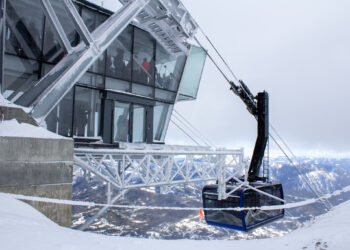By Marshall Swearingen MSU News Service
As the Aug. 21 total solar eclipse draws near, Montana State University researcher Angela Des Jardins has some advice for viewing the rare and awe-inspiring celestial event.
“It’s really a once-in-a-lifetime opportunity,” said Des Jardins, who has been preparing for the eclipse for more than three years. To make the most of it, people should be prepared and plan one or more ways of viewing the eclipse, she said.
The last total solar eclipse that was visible from the contiguous U.S. occurred in 1979; the next ones won’t take place until 2024 and 2045. During a total solar eclipse, the moon aligns perfectly with the sun and obscures it entirely.
First, Des Jardins said, be safe. Even during an eclipse, looking at the sun can cause permanent eye damage. In the Bozeman area, where viewers will see a partial eclipse in which the moon will obscure 95 percent of the sun, it will be necessary to wear protective glasses the entire time.
Glasses are inexpensive and are available online. It’s important to purchase glasses that comply with international safety standard ISO 12312-2, Des Jardins said. Information about obtaining free glasses at MSU can be found at www.coe.montana.edu/eclipse/viewing.html.
Starting at 10 a.m. on Aug. 21 in front of the MSU Library, members of the MSU Physics Department will distribute glasses and will also have solar telescopes and other special viewing equipment. In Bozeman, the partial eclipse will begin at roughly 10 a.m. and will peak at 11:36 a.m.
Second recommendation: If at all possible, Des Jardins said, go to the path of totality—the roughly 70-mile-wide area stretching from Oregon to South Carolina where viewers will experience the total eclipse. There, the moon will completely block the sun for about two minutes, producing the most dramatic effect.
“If you don’t do it, you might really regret it later,” Des Jardins said.
Although she hasn’t witnessed a total solar eclipse in person, Des Jardins, an assistant research professor in the Department of Physics in MSU’s College of Letters and Science and director of the Montana Space Grant Consortium at MSU, has studied the phenomenon enough to know that experiencing it is profound.
“It’s kind of a deep twilight, with basically a 360-degree sunset,” she said. “Some of the brightest stars will come out.” The sun’s violent atmosphere, called the corona, will become visible as a ring around the moon, “which is an amazing thing to be able to see.”
During the period of totality, viewers can safely look at the eclipse without glasses.
The path of totality includes a tiny and remote corner of southwestern Montana, as well as Idaho Falls and Rexburg in Idaho and Jackson, Thermopolis and Casper in Wyoming. If you go, be prepared for crowds and traffic and bring plenty of water and food, Des Jardins said. Cellphone service may be temporarily unavailable due to high demand.
Third: Watch the aerial video that an MSU team and 54 other teams will livestream using high-altitude balloons as part of the MSU-led Eclipse Ballooning Project. A team of MSU students, mostly undergraduates, has spent countless hours designing and building a system that project teams across the country will use to provide a unique perspective on the eclipse.
“It’s a space-like perspective,” said Des Jardins, who initiated the project in 2014. Helium-filled balloons will carry cameras to an altitude of more than 80,000 feet to capture the video. “From that height you can see the curvature of the Earth and the blackness of space.”
“You’ll get to feel like you’re looking down on planet Earth,” she said. “It will invoke wonder and curiosity about what’s happening, the special alignment that has to happen for the shadow to move across the Earth.”
The video from all the teams will be livestreamed to NASA’s website. During the eclipse, the MSU homepage will link to a livestream transmitted from one of the MSU team’s three balloons, which the team will launch from the Rexburg area.
The livestream is meant to complement viewing the eclipse directly, not replace the experience, Des Jardins said. She recommends viewing the livestream during the hour before or after the local peak of the eclipse. Teams will be livestreaming from more than a dozen balloons in Oregon and Idaho before the eclipse peaks in Bozeman.
The Museum of the Rockies will show the Eclipse Ballooning Project livestream at the Taylor Planetarium. Doors open at 10 a.m. and normal admission charges apply. Eclipse glasses will also be available for purchase.
Regardless of how or where people view the eclipse, Des Jardins is encouraging everyone to take time to experience the extraordinary happening.
“There will be something special about seeing it with your own two eyes,” she said, “but there will also something pretty profound about seeing those images looking down on the planet.”















